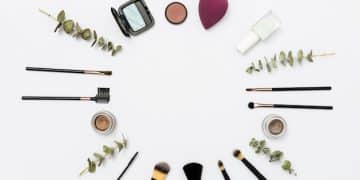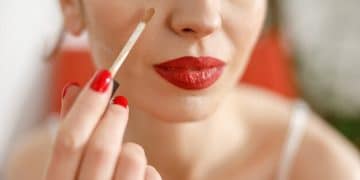Highlighting and Strobing: Your Guide to a Radiant Glow
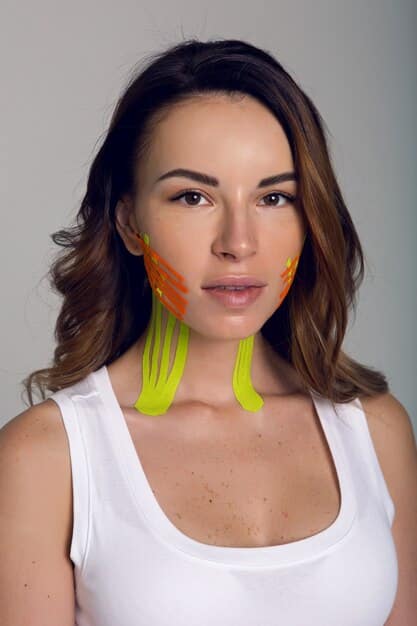
Highlighting and strobing are makeup techniques used to enhance your features and create a radiant, glowing complexion, by strategically applying light-reflecting products to the high points of the face.
Want to achieve that coveted “lit-from-within” glow? Highlighting and strobing are the makeup techniques you need to master. Let’s dive into how to use them for a radiant complexion.
Understanding Highlighting and Strobing
Highlighting and strobing are integral techniques in modern makeup, designed to sculpt the face and impart a healthy, radiant glow. While often used interchangeably, they have distinct nuances that, when understood, can elevate your makeup game.
At their core, both techniques involve using light to enhance certain facial features. However, the approach and the products typically used differ slightly, leading to varying effects. Let’s explore these differences to help you determine which technique—or combination of techniques—best suits your desired look.
Highlighting: Definition and Purpose
Highlighting involves using products that are lighter than your natural skin tone to bring forward specific areas of the face. These areas are usually the high points where light naturally hits.
Strobing: Definition and Purpose
Strobing, on the other hand, focuses exclusively on using light-reflective products to create a dewy, luminous finish. It’s all about maximizing glow and enhancing the skin’s natural radiance.
- Highlighting uses both matte and shimmer products to add dimension.
- Strobing primarily utilizes shimmer and glitter to emphasize facial features with glow.
- Highlighting can subtly sculpt the face, while strobing focuses on creating an overall radiant look.
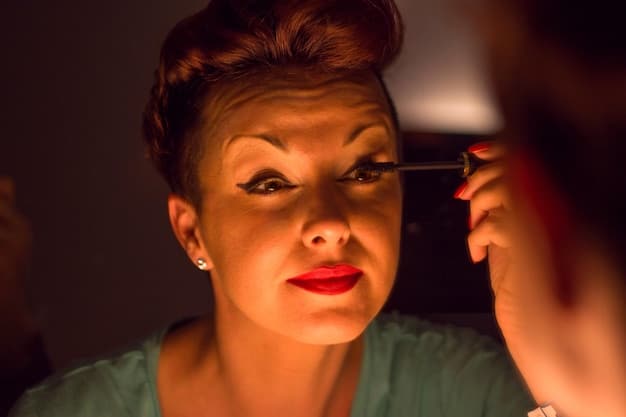
In essence, understanding the core purpose of highlighting and strobing—sculpting versus illuminating—will guide you in selecting the appropriate product and application technique. Both aim to enhance your natural beauty, but they achieve this through slightly different means. As you experiment with both, you’ll discover which one aligns best with your personal style and skin type.
Choosing the Right Products for Highlighting and Strobing
Selecting the correct products is paramount for achieving a flawless, radiant look with highlighting and strobing. The market offers a plethora of options, each with varying textures, finishes, and undertones. Understanding these nuances will empower you to make informed choices that complement your skin type, tone, and desired effect.
Whether you’re aiming for a subtle, natural glow or a bold, statement highlight, the right product can make all the difference. Let’s delve into the different types of highlighters and strobing creams available and how to choose the best ones for you.
Types of Highlighters
Highlighters come in several forms, each offering a unique finish and application style. These include powder, cream, liquid, and stick highlighters.
Types of Strobing Creams
Strobing creams are typically liquid or cream-based and are designed to impart an all-over luminosity. They can be used alone or mixed with foundation.
- Consider your skin type when selecting a highlighter or strobing cream. Powder highlighters are generally better for oily skin, while creams and liquids work well for dry skin.
- Choose a shade that complements your skin tone. Fair skin tones look best with cool, pearlescent shades, while warmer skin tones can pull off gold, peach, and bronze hues.
- Think about the intensity you want to achieve. Strobing creams deliver a more intense glow, while highlighters often provide a subtler effect.
By carefully considering your skin type, tone, and desired intensity, you can select the perfect products to enhance your features and achieve a radiant, lit-from-within glow. Experiment with different types to discover what works best for you and don’t be afraid to mix and match for a customized look.
Mastering the Application Techniques
The effectiveness of highlighting and strobing lies not only in choosing the right products but also in mastering the correct application techniques. Strategic placement and blending are crucial for creating a seamless, natural-looking glow that enhances your features without appearing artificial.
Different areas of the face benefit from highlighting and strobing, and the application method can vary depending on the desired effect. Let’s explore the best practices for applying these techniques to achieve a flawless, radiant complexion.
Highlighting Application Techniques
Apply highlighter to the high points of your face, such as the cheekbones, brow bone, cupid’s bow, and the bridge of your nose.
Strobing Application Techniques
Strobing should be applied to areas where light naturally hits, creating a dewy, all-over glow. Focus on the cheekbones, temples, and along the brow bone.
- Use a light hand when applying highlighter and strobing cream. Build up the intensity gradually to avoid overdoing it.
- Blend the product seamlessly into your skin using a makeup sponge or brush.
- Set your highlighter or strobing cream with a light dusting of translucent powder, especially if you have oily skin.
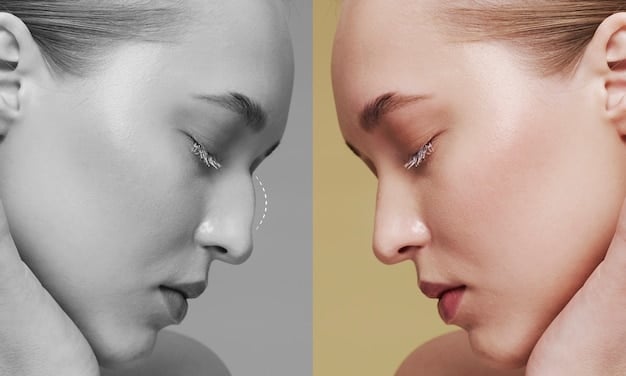
Mastering the application techniques for highlighting and strobing requires practice and patience. Experiment with different placements and blending methods to find what works best for your facial structure and desired level of intensity. With the right techniques, you can achieve a radiant, lit-from-within glow that enhances your natural beauty.
Highlighting and Strobing for Different Skin Tones
Highlighting and strobing are not one-size-fits-all techniques. The shades and intensity of highlighters and strobing creams should be carefully chosen to complement different skin tones.
What works beautifully on one skin tone may appear ashy or too intense on another. Understanding the nuances of matching these techniques to your skin tone is essential for achieving a natural, flattering glow. Let’s explore the best practices for highlighting and strobing based on various skin tones.
Highlighting and Strobing for Fair Skin Tones
Fair skin tones often look best with cool-toned, pearlescent highlighters and strobing creams.
Highlighting and Strobing for Medium Skin Tones
Medium skin tones can pull off a wider range of shades, including champagne, gold, and peach.
- Choose subtle, cool-toned highlighters for fair skin, avoiding overly warm shades that can look orange.
- Opt for warm, golden, or bronze highlighters and strobing creams for deep skin tones to enhance the skin’s natural warmth.
- Experiment with various shades to find what complements your undertones best.
Achieving a perfect glow with highlighting and strobing involves understanding your skin tone and selecting products that enhance its natural beauty. Don’t be afraid to experiment with different shades and intensities to discover what works best for you. With the right approach, you can create a radiant, flattering look that complements your unique complexion.
Highlighting and Strobing for Different Skin Types
In addition to skin tone, your skin type plays a significant role in determining the best products and techniques for highlighting and strobing. Different skin types have varying levels of oil production and texture, which can affect how highlighters and strobing creams appear and wear throughout the day.
Understanding your skin type – whether it’s oily, dry, combination, or sensitive – will help you choose products that not only enhance your features but also work with your skin’s natural characteristics. Let’s explore the best practices for highlighting and strobing based on different skin types.
Highlighting and Strobing for Oily Skin
Oily skin tends to produce excess sebum, which can cause highlighters and strobing creams to appear overly shiny or greasy.
Highlighting and Strobing for Dry Skin
Dry skin lacks natural moisture, which can cause highlighters and strobing creams to cling to dry patches or appear dull.
- Opt for powder highlighters and oil-free strobing creams for oily skin to control shine and minimize excess oil production.
- Use hydrating primers and moisturizers under your highlighter or strobing cream to create a smooth, dewy base for dry skin.
- Consider using cream or liquid highlighters for combination skin, focusing on drier areas and avoiding the T-zone.
By considering your skin type, you can select products and techniques that not only enhance your features but also work with your skin’s natural characteristics. Adjust your approach based on your skin’s needs, opting for products that promote balance, hydration, and a flawless finish.
Common Mistakes to Avoid
While highlighting and strobing can enhance your complexion, several common mistakes can lead to an unnatural or unflattering look. Avoiding these pitfalls will help you achieve a seamless, radiant glow.
From choosing the wrong shade to over-applying product, these mistakes are easily avoidable with a little awareness and practice. Let’s explore some of the most common highlighting and strobing errors and how to correct them for a flawless finish.
Over-Applying Product
Applying too much highlighter or strobing cream can result in a harsh, artificial look.
Using the Wrong Shade
Choosing a highlighter or strobing cream that doesn’t complement your skin tone can make your skin appear ashy or unnatural.
- Start with a small amount of product and build up the intensity gradually to avoid over-application.
- Select a shade that complements your skin tone and undertones, testing it in natural light to ensure it looks seamless.
- Use the right tools for application, such as a fan brush for powder highlighters and a makeup sponge for creams and liquids.
By being mindful of these common mistakes and taking steps to avoid them, you can achieve a flawless, radiant glow that enhances your natural beauty. Pay attention to the amount of product you use, choose shades that complement your skin tone, and use the right tools for a seamless application. With practice, you’ll master highlighting and strobing like a pro.
| Key Point | Brief Description |
|---|---|
| ✨ Highlighting | Uses lighter shades to bring forward areas like cheekbones. |
| 🌟 Strobing | Focuses on light-reflective products for a dewy finish. |
| 🎨 Application | Blend well on high points; use a light hand. |
| 👩🦰 Skin Tone | Match shades to your skin tone for a natural glow. |
Frequently Asked Questions
▼
Highlighting uses lighter shades to sculpt the face, while strobing focuses solely on light-reflective products for a dewy glow. Highlighting can be more subtle whereas strobing often creates a more intense radiance.
▼
Fair skin tones look best with cool, pearlescent highlighters. Medium skin tones can pull off champagne, gold, and peach shades. Deep skin tones should opt for warm, golden, or bronze highlighters to enhance natural warmth.
▼
Absolutely! Combining highlighting and strobing can create a multidimensional, radiant look. Apply highlighter to sculpt the face and then use strobing cream on the high points to amplify the glow for a stunning result.
▼
Use a light hand when applying highlighter and blend it seamlessly into your skin. Start with a small amount of product and build up the intensity gradually. Avoid over-applying and focus on the high points for a natural look.
▼
A fan brush works great for powder highlighters, providing a diffused, natural finish. For creams and liquids, use a makeup sponge or your fingertips to blend the product seamlessly into your skin with even distribution.
Conclusion
Mastering highlighting and strobing is a surefire way to achieve a radiant, lit-from-within glow that enhances your natural beauty. By understanding the nuances of both techniques, selecting the right products for your skin tone and type, and practicing the proper application methods, you can create a flawless, head-turning look. So go ahead, experiment with highlighting and strobing, and let your inner radiance shine through.
